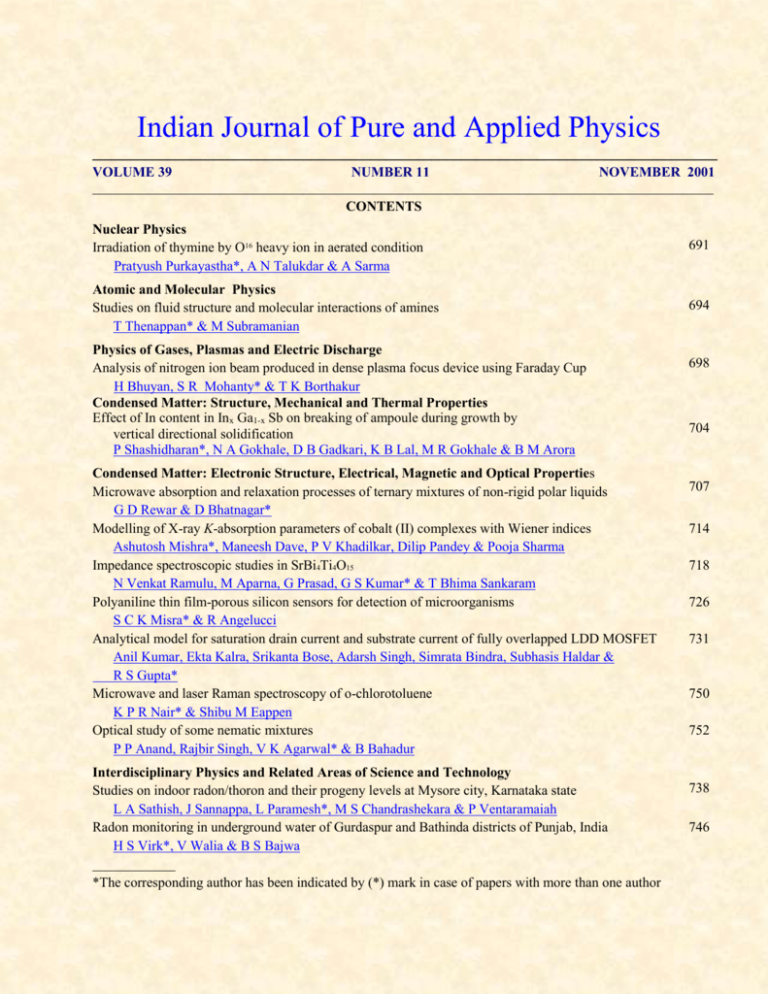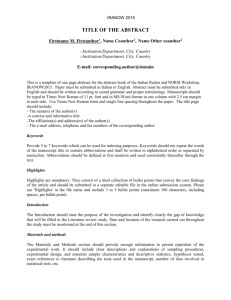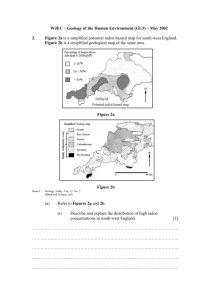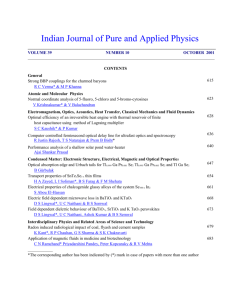novemweb
advertisement

Indian Journal of Pure and Applied Physics ___________________________________________________________________________________ VOLUME 39 NUMBER 11 NOVEMBER 2001 __________________________________________________________________________________________ CONTENTS Nuclear Physics Irradiation of thymine by O16 heavy ion in aerated condition Pratyush Purkayastha*, A N Talukdar & A Sarma 691 Atomic and Molecular Physics Studies on fluid structure and molecular interactions of amines T Thenappan* & M Subramanian 694 Physics of Gases, Plasmas and Electric Discharge Analysis of nitrogen ion beam produced in dense plasma focus device using Faraday Cup H Bhuyan, S R Mohanty* & T K Borthakur Condensed Matter: Structure, Mechanical and Thermal Properties Effect of In content in Inx Ga1-x Sb on breaking of ampoule during growth by vertical directional solidification P Shashidharan*, N A Gokhale, D B Gadkari, K B Lal, M R Gokhale & B M Arora Condensed Matter: Electronic Structure, Electrical, Magnetic and Optical Properties Microwave absorption and relaxation processes of ternary mixtures of non-rigid polar liquids G D Rewar & D Bhatnagar* Modelling of X-ray K-absorption parameters of cobalt (II) complexes with Wiener indices Ashutosh Mishra*, Maneesh Dave, P V Khadilkar, Dilip Pandey & Pooja Sharma Impedance spectroscopic studies in SrBi4Ti4O15 N Venkat Ramulu, M Aparna, G Prasad, G S Kumar* & T Bhima Sankaram Polyaniline thin film-porous silicon sensors for detection of microorganisms S C K Misra* & R Angelucci Analytical model for saturation drain current and substrate current of fully overlapped LDD MOSFET Anil Kumar, Ekta Kalra, Srikanta Bose, Adarsh Singh, Simrata Bindra, Subhasis Haldar & R S Gupta* Microwave and laser Raman spectroscopy of o-chlorotoluene K P R Nair* & Shibu M Eappen Optical study of some nematic mixtures P P Anand, Rajbir Singh, V K Agarwal* & B Bahadur Interdisciplinary Physics and Related Areas of Science and Technology Studies on indoor radon/thoron and their progeny levels at Mysore city, Karnataka state L A Sathish, J Sannappa, L Paramesh*, M S Chandrashekara & P Ventaramaiah Radon monitoring in underground water of Gurdaspur and Bathinda districts of Punjab, India H S Virk*, V Walia & B S Bajwa ____________ *The corresponding author has been indicated by (*) mark in case of papers with more than one author 698 704 707 714 718 726 731 750 752 738 746 Indian Journal of Pure & Applied Physics Vol. 39, November 2001, pp. 691-693 Irradiation of thymine by O16 heavy ion in aerated condition Pratyush Purkayastha1, A N Talukdar1 & A Sarma2 1Department of Physics, Gauhati University, Guwahati, Assam 781 014 2Nuclear Science Centre, New Delhi 110 067 Received 28 March 2001, accepted 4 September 2001 Aqueous solutions of thymine have been irradiated with O16 heavy ion beam in aerated condition with different concentrations. The degradation of thymine bases is monitored by the change in concentration with UV visible spectrophotometer. The observed results have been compared with those reported earlier. The dose rate was found to be decisive factor in determining the course of radiolysis. Indian Journal of Pure & Applied Physics Vol. 39, November 2001, pp. 694-697 Studies on fluid structure and molecular interactions of amines T Thenappan & *M Subramanian Department of Physics, Alagappa University, Karaikudi 630 003 Received 4 April 2001; revised 8 August 2001; accepted 24 September 2001 Fluid structure in amines could be readily studied by dielectric measurements by virtue of the influence of local order and the overall dipole moment. The short range interaction between permanent dipoles could be described by the Kirkwood-Frohlich correlation factor. In dilute solutions of amines with inert solvents, the interaction between the solute species among themselves may be given by a modified form of the correlation factor (g') by taking the solute-solvent and solvent-solvent interaction. Dielectric constant of the binary mixtures of monoethanolamine and diethanolamine in 1,4 dioxan and triethylenetetramine and cyclohexylamine in benzene were measured at 298, 308 and 318 K. The values of Kirkwood-Frohlich correlation factor (g') were determined at the temperatures mentioned above. The results are interpreted in the light of the theory. The presence of α and β multimers in the above systems was identified. Indian Journal of Pure & Applied Physics Vol. 39, November 2001, pp. 698-703 Analysis of nitrogen ion beam produced in dense plasma focus device using Faraday Cup H Bhuyan, S R Mohanty* & T K Borthakur Centre of Plasma Physics, Dispur, Guwahati 781 006 and R S Rawat Department of Physics/ Electronics, SGTB Khalsa College, University of Delhi, Delhi 110 007 Received 23 December 2000; accepted 7 April 2001 A nanosecond response Faraday Cup was fabricated and employed to characterize pulsed ion beam of a 2.2 kJ Mather type Dense Plasma Focus Device. The Faraday Cup operating in bias ion collector mode was used to determine the energy spectrum and flux of fast nitrogen ion beam along the electrode axis (0) of the device. It has been possible to register the ion energy up to a lower kinetic energy threshold of ~7 keV which is a value much lower than that obtained in any previous works. The correlation of the ion beam intensity with filling gas pressure is also reported. Indian Journal of Pure & Applied Physics Vol. 39, November 2001, pp. 704-706 Effect of In content in InxGa1-xSb on breaking of ampoule during growth by vertical directional solidification P Shashidharan1, N A Gokhale3, D B Gadkari2, K B Lal3, M R Gokhale4 & B M Arora4 1Department of Physics, Vartak College, Vasai Road (W), Mumbai 401 202 2 Department of Physics, Mithibai College, Vile Parle, Mumbai 400 056 3Department 4Solid of Physics, University of Mumbai, Vidyanagari, Mumbai 400 098 State Electronics, Tata Institute of Fundamental Research, Mumbai 400 005 Received 28 March 2001; revised 27 June 2001 InGaSb crystals have been grown using vertical directional solidification (VDS) technique in closed conical quartz ampoules. InxGa1-xSb Crystals with different In mole fractions in the melt (x = 0.1, 0.25, 0.5 and 0.75) have been grown to study the effect of mole fraction on the breaking of the ampoule. Growth with In mole fraction x = 0.5 in the melt resulted in breaking of the ampoule. For other compositions, no breaking of the ampoule occurred. The problem of breaking of ampoule was circumvented by encapsulating the material containing quartz ampoule in another quartz ampoule. The double ampoule prevents the melt from coming into contact with atmospheric air in case of a breakage enabling the growth of crystals from melts with 50 % In composition. Sticking of the ingot to the ampoule has not been observed for any of the compositions. Indian Journal of Pure & Applied Physics Vol. 39, November 2001, pp. 707-713 Microwave absorption and relaxation processes of ternary mixtures of non-rigid polar liquids G D Rewar & D Bhatnagar Microwave Laboratory, Department of Physics University of Rajasthan, Jaipur 302 004 Received 2 March 2001; revised 24 July 2001; accepted 7 September 2001 The dielectric absorption of three acrylates and their mixture compositions as liquid dielectric samples have been studied at MW frequency 9.132 GHz in dilute solution of carbon tetrachloride in the temperature range 300-330 K. Different dielectric parameters like dielectric constant and dielectric loss at microwave frequency, dielectric constant s at static frequency and dielectric constant at optical frequency have been determined. Using these dielectric data, distribution parameter , various relaxation times, viz. o, 1, and 2 of individual components and their ternary mixture compositions have been calculated. Thermo dynamical parameters like molar energy of activation F molar enthalpy of activation H and molar entropy of activation S have been evaluated by considering the relaxation as the rate process. Variation of ln (2T) versus 1/T indicates exponential decay of relaxation time with temperature for dielectric relaxation process. The relaxation time values for single component solutions agree well with literature values while relaxation times of ternary mixture compositions are consistent with the computed values obtained from various theoretical relations. Indian Journal of Pure & Applied Physics Vol. 39, November 2001, pp. 714-717 Modeling of X-ray K-absorption parameters of cobalt (II) complexes with Wiener indices Ashutosh Mishra, Maneesh Dave, PV Khadikar, Dilip Pandey & Pooja Sharma School of Physics, Devi Ahilya University, Indore 452 017 Received 5 October 2000, revised 13 July 2001, accepted 21 September 2001 An application has been used in modeling the X-ray absorption parameters. The use of Wiener index (W) for estimating, predicting and comparing the X-ray K-absorption parameters of some cobalt (II) complexes of a series of benzohydroxamic acid ligands has been described. The K-absorption parameters used are chemical shift (EK), fractional oxidation number (Zeff), shift of principal absorption maximum and edge-width for this purpose. The results obtained with regression analysis of the data show that Wiener indices (W) can be successfully used for estimating these parameters. Indian Journal of Pure & Applied Physics Vol. 39, November 2001, pp. 718-725 Impedance spectroscopic studies in SrBi4Ti4O15 N Venkat Ramulu, M Aparna, G Prasad, G S Kumar & T Bhima Sankaram Materials Research Laboratory, Department of Physics, Osmania University, Hyderabad 500 007 Received 20 March 2001; revised 15 June 2001; accepted 22 August 2001 The impedance measurements have been performed in the temperature range of 30 to 600 C and the frequency range 1 kHz to 10 MHz on four-layered SrBi4Ti4O15. The imaginary components of impedance Z '', the electrical modulus M'' and ac conductivity have been computed, both as a function of frequency and temperature. The peaks appear in Z'' versus frequency plots and they shift towards lower frequencies at the temperature up to 500 C and above 525 C they shift towards higher frequencies. Similar behaviour is observed in M '' versus frequency plots. |Z ''| values decrease with increase of temperature, while |M''| values decrease up to 500 C and above 525 C these values are found to increase with temperature. Complex impedance diagrams are nearly semicircles at higher temperatures. Results are interpreted in terms of possible conductivity mechanisms present in the sample. Indian Journal of Pure & Applied Physics Vol. 39, November 2001, pp. 726-730 Polyaniline thin film-porous silicon sensors for detection of microorganisms S C K Misra & R Angelucci* National Physical Laboratory, New Delhi 110 012 *CNR-LAMEL, Institute, Bologna, Italy Received 15 May 2001, revised 2 August 2001, accepted 24 September 2001 Quick and simple methods to detect the type of life threatening microbial species are very essential in food and water contaminated with bacteria. Recently, by utilizing the semiconducting polymeric thin films prepared on silicon macroporous substrates a new technology for detection of micro-organisms has been developed. The advantages of the polymeric devices are the ease of fabrication, the high sensitivity to micro-organisms, the fast response time and the room temperature operation. In this work the current voltage characteristics and the dielectric losses variations of the specifically doped polymeric thin films deposited on silicon macroporous membranes upon exposure to E. Colii were studied. The sensors were prepared by vacuum depositing doped polyaniline in the form of thin films on the silicon macroporous structures. The particular doping combination in the polymer makes the sensor specific for detection of E. Colii. Moreover the sensitivity of the to E. Colii is very high and the response time of the sensor is about 5 sec. The total response time is a few tens of seconds. The macroporous silicon substrate allows to obtain a polyaniline thin film with high specific surface area and good crystallinity, as shown by SEM and X-ray investigations, respectively. Both the high surface area and the crystallinity of the polyaniline film deposited on the macroporous silicon substrate are believed to be responsible for the excellent properties of the sensor device. The fabrication process, the morphological, structural and electrical characterization of the hybrid polymeric/ silicon micro-sensors in regard to detection of E. Colii have been described. Indian Journal of Pure & Applied Physics Vol. 39, November 2001, pp. 731-737 Analytical model for saturation drain current and substrate current of fully overlapped LDD MOSFET Anil Kumar, *Ekta Kalra, Srikanta Bose, Adarsh Singh, Simrata Bindra, **Subhasis Haldar & R S Gupta Semiconductor Devices Research Laboratory, Department of Electronic Science, South Campus, University of Delhi, New Delhi 110 021 Multi Media University, Jalan Ayer Keroh Lama, 75450, Melaka, Malaysia Department of Physics, Motilal Nehru College, Benito Juarez Road, New Delhi110 021 Received 20 April 2001; revised 9 July 2001; accepted 27 July 2001 An analytic model for saturation drain current and substrate current of fully overlapped lightly doped drain (FOLD) MOSFET is developed using pseudo-two-dimensional approximation in the channel and drain regions and expression of maximum electric field is obtained. An expression for channel length modulation factor is also developed and the substrate current is calculated. Indian Journal of Pure & Applied Physics Vol. 39, November 2001, pp. 750-751 NOTE Microwave and laser Raman spectroscopy of o-chlorotoluene K P R Nair & Shibu M Eappen Laser and Spectroscopy Laboratory, Department of Physics, Cochin University of Science & Technology, Cochin 682 022 Received 11 April 2001; accepted 7 September 2001 The microwave spectrum of o-chlorotoluene C6H4CH3Cl shows distinct rotational structures due to four excited vibrational states over and above the ground state spectrum. The vibrational frequency calculated from the relative intensities of the ground and first excited states in the microwave spectra is identified in the laser Raman spectra and is believed to be the first torsional state of the molecule. Indian Journal of Pure & Applied Physics Vol. 39, November 2001, pp. 752-754 NOTE Optical study of some nematic mixtures P P Anand1, Rajbir Singh1, V K Agarwal2 & B Bahadur3 1Physics Department, Meerut College, Meerut (UP) 2Physics Department, CCS University, Meerut (UP) 3Rockwell Collins Inc, Cedar Rapids, IA 52498-3161 Received 15 April, 2001; accepted 3 August 2001 Optical birefrigence study of four multi-component nematic mixtures E-80, E-90, E-100 and E-110 (all from E.Merck), were carried out, providing information about their transition temperatures and microscopic order parameter (S). Indian Journal of Pure & Applied Physics Vol. 39, November 2001, pp. 738-745 Studies on indoor radon/thoron and their progeny levels at Mysore city, Karnataka state L A Sathish, J Sannappa, L Paramesh, M S Chandrashekara & P Venkataramaiah Department of Studies in Physics, University of Mysore, Manasagangotri, Mysore 570 006 Received 17 April 2001; revised 2 July 2001; accepted 20 September 2001 Radon, thoron and their progeny concentrations have been measured in different types of buildings at different locations in Mysore city over a period of 2 years using solid state nuclear track detector (SSNTD) method. The dose to the selected population of Mysore city has been estimated. The arithmetic mean (AM) values of concentrations of radon and thoron in indoor atmosphere ranged from 9.20 to 58.02 Bq m-3 with a median of 34 Bq m-3 and 7.21 to 59.27 Bq m-3 with a median of 33 Bq m-3, respectively. The arithmetic mean of progeny concentrations varies from 0.033 to 2.52 mWL with a median of 1.29 and 0.074 to 47.04 mWL with a median of 20.7, respectively. The dose to the selected population of Mysore city has been found to be 1.58 mSv y-1. The concentrations of radon/thoron and their progeny vary with the type of flooring and ventilation conditions. Diurnal and seasonal variations have also been observed. Higher radon concentration has been found during nights and early morning hours. Indian Journal of Pure & Applied Physics Vol. 39, November 2001, pp. 746-749 Radon monitoring in underground water of Gurdaspur and Bathinda districts of Punjab, India H S Virk, V Walia & B S Bajwa Department of Physics, Guru Nanak Dev University, Amritsar 143 005 Received 9 May 2001; revised 30 August 2001; accepted 11 September 2001 Radon monitoring has become a global phenomenon due to its health hazard. More than 55 % radiation dose delivered to the human kind on the globe from all natural sources is due to radon alone. Radon measurements have been carried out in groundwater in Gurdaspur and Bathinda districts of Punjab, India. Radon concentration values in potable water show a wide variation depending on its source and location. Generally, radon concentration values in hand-pump drawn groundwater have been found to be higher than the values determined for water supplied from other sources. Mineral water has the minimum radon concentration compared with groundwater sources. No correlation is found between radon concentration and uranium content of groundwater in Bathinda district.








